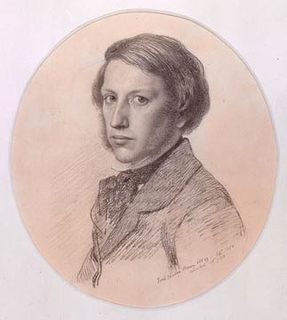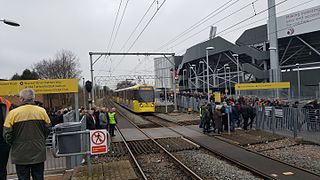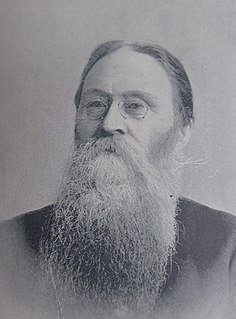
Ford Madox Brown was a British painter of moral and historical subjects, notable for his distinctively graphic and often Hogarthian version of the Pre-Raphaelite style. Arguably, his most notable painting was Work (1852–1865). Brown spent the latter years of his life painting the twelve works known as The Manchester Murals, depicting Mancunian history, for Manchester Town Hall.
The year 1893 in art involved some significant events.

Parade's End is a tetralogy of novels by the British novelist and poet Ford Madox Ford, written from 1924 to 1928. The novels chronicle the life of a member of the English gentry before, during and after World War I. The setting is mainly England and the Western Front of the First World War, in which Ford had served as an officer in the Welch Regiment, a life he vividly depicts. The individual novels are Some Do Not ... (1924), No More Parades (1925), A Man Could Stand Up — (1926) and Last Post (1928).

Stretford is a market town in Trafford, Greater Manchester, England, on flat ground between the River Mersey and the Manchester Ship Canal, 3.8 miles (6.1 km) south of Manchester city centre, 3.0 miles (4.8 km) south of Salford and 4.2 miles (6.8 km) northeast of Altrincham. Stretford borders Chorlton-cum-Hardy to the east, Moss Side and Whalley Range to the southeast, Hulme to the northeast, Urmston to the west, Salford to the north, and Sale to the south. The Bridgewater Canal bisects the town.

Old Trafford is an area of Stretford in the Metropolitan Borough of Trafford, Greater Manchester, England, two miles (3.2 km) southwest of Manchester city centre. It is roughly delineated by two old toll gates; Brooks's Bar and Trafford Bar, to the east and west.

The Royal Cornwall Polytechnic Society is an educational, cultural and scientific charity, as well as a local arts and cinema venue, based in Falmouth, Cornwall, England, United Kingdom. The Society exists to promote innovation in the arts and sciences.

White City is a retail park on Chester Road in Old Trafford, Greater Manchester, England. At the southeast corner of the docks area and southeast of Manchester United's ground, it is the site of the former Manchester Botanic Gardens which hosted the Art Treasures Exhibition of 1857. The gateway of the Botanic Gardens still stands at the edge of the retail park. During its history, White City has also been the site of an amusement park and a sports stadium for athletics, greyhound and stock car racing.

Trafford Park is an area of the Metropolitan Borough of Trafford, Greater Manchester, England, opposite Salford Quays on the southern side of the Manchester Ship Canal, 3.4 miles (5.5 km) southwest of Manchester city centre and 1.3 miles (2.1 km) north of Stretford. Until the late 19th century, it was the ancestral home of the Trafford family, who sold it to financier Ernest Terah Hooley in 1896. Occupying an area of 4.7 square miles (12 km2), it was the first planned industrial estate in the world, and remains the largest in Europe well over a century later.

Old Trafford is a tram stop on the Altrincham Line of the Metrolink light rail system in Old Trafford, Greater Manchester, England.

The Manchester Murals are a series of twelve paintings by Ford Madox Brown in the Great Hall of Manchester Town Hall and are based on the history of Manchester. Following the success of Brown's painting Work he was commissioned to paint six murals for its Great Hall. Another six murals were to be completed by Frederic Shields who later withdrew, leaving Brown to complete all twelve works. The murals were begun in 1879, towards the end of Brown's career, but were not completed until 1893, the year he died. During this period he moved from London to Manchester with his family, first living in Crumpsall and then Victoria Park.

Frederic James Shields was a British artist, illustrator, and designer closely associated with the Pre-Raphaelites through Dante Gabriel Rossetti and Ford Madox Brown.

Susan Isabel Dacre (1844–1933), known as Isabel Dacre, was an English artist of the Victorian era.

Alfred Darbyshire was a British architect.
Ford Trafford Park Assembly Plant was a car assembly plant established by Ford of Britain at Trafford Park, beside the Manchester Ship Canal, a short distance to the west of Manchester. It was the first manufacturing plant established by Ford outside the United States, though originally it was established merely to assemble vehicles using parts imported from Dearborn.
The Art Treasures of Great Britain was an exhibition of fine art held in Manchester, England, from 5 May to 17 October 1857. It remains the largest art exhibition to be held in the UK, possibly in the world, with over 16,000 works on display. It attracted over 1.3 million visitors in the 142 days it was open, about four times the population of Manchester at that time, many of whom visited on organised railway excursions. Its selection and display of artworks had a formative influence on the public art collections that were then being established in the UK, such as the National Gallery, National Portrait Gallery and the Victoria and Albert Museum.
The Manchester School of Painters was formed by a number of disgruntled young vanguard painters in the 1870s. They were deeply influenced by the artist Joseph Knight, who was a successful painter, etcher and photographer. He was the founder member of the Manchester School of Painters. Knight painted how he desired and refused to conform to traditional Art School rules and this appealed to his young admirers. Twice weekly they would all meet up at Knight’s studio in York Place behind the Union Chapel in Oxford Road, Manchester to discuss new ways to develop their techniques.

Lucy Madox Brown Rossetti was a British artist, author, and model associated with the Pre-Raphaelites. She was married to the writer and art critic William Michael Rossetti.

Maxwell and Tuke was an architectural practice in Northwest England, founded in 1857 by James Maxwell in Bury. In 1865 Maxwell was joined in the practice by Charles Tuke, who became a partner two years later. The practice moved its main office to Manchester in 1884. Frank, son of James Maxwell, joined the practice in the later 1880s and became a partner. The two senior partners both died in 1893, and Frank Maxwell continued the practice, maintaining its name as Maxwell and Tuke.

The Adelaide International Jubilee Exhibition of 1887 was a celebration of the 50th anniversary of Queen Victoria's accession to the throne on 20 June 1837, held in Adelaide, South Australia in 1887. It was also a celebration of the 50th anniversary of the Proclamation of South Australia which occurred around six months earlier, on 28 December 1886.

The Lancashire and Yorkshire Railway (L&YR) Barton Wright 4-4-0 was four-coupled eight-wheeled bogie express engine which entered service in 1880.















